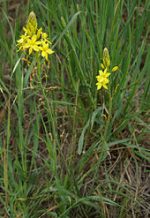 Also called golden lily, leek lily, wild onion, yellow onion weed, and native leek, this succulent perennial is a member of the Asphodelaceae that also includes aloe, torch lily (Kniphofia), and foxtail lily (Eremus). It is endemic of Australia where it grows in dense colonies in a variety of habitats including forests, grasslands, rock crevices and areas where the soil is seasonally inundated. Plants have a bulblike corm that produces a tuft of narrow basal gray-green leaves up to 16″ long . The stary 1′ flowers are fragrant, bright yellow and carried in loose racemes of 50 on a slender scape up to 24″. Each flower has 6 tepals and densely bearded stamen filaments. Although each flower only blooms for a single day the plants remain in flower over a long time. Bulbine lily is a good choice for a cottage garden, rock garden, and containers. It may be poisonous to livestock if eaten in large quantities. The generic name, Bulbine, comes from the Greek word bolbos, meaning bulb and mistakenly refers to the reproductive structure of the plant which is actually a corm. The specific epithet, bulbose, also refers mistakenly to the reproductive structure.
Also called golden lily, leek lily, wild onion, yellow onion weed, and native leek, this succulent perennial is a member of the Asphodelaceae that also includes aloe, torch lily (Kniphofia), and foxtail lily (Eremus). It is endemic of Australia where it grows in dense colonies in a variety of habitats including forests, grasslands, rock crevices and areas where the soil is seasonally inundated. Plants have a bulblike corm that produces a tuft of narrow basal gray-green leaves up to 16″ long . The stary 1′ flowers are fragrant, bright yellow and carried in loose racemes of 50 on a slender scape up to 24″. Each flower has 6 tepals and densely bearded stamen filaments. Although each flower only blooms for a single day the plants remain in flower over a long time. Bulbine lily is a good choice for a cottage garden, rock garden, and containers. It may be poisonous to livestock if eaten in large quantities. The generic name, Bulbine, comes from the Greek word bolbos, meaning bulb and mistakenly refers to the reproductive structure of the plant which is actually a corm. The specific epithet, bulbose, also refers mistakenly to the reproductive structure.
Type: Succulent perennial
Bloom: Loose raceme of starry yellow flowers with six tepals and densely bearded stamen filaments
Size: 18-24″ x 12″ W
Light:Full sun; tolerates some shade
Soil:Average, medium moist, well-drained
Hardiness: Zones 8-10
Care: Remove spent flower stalks
Pests and Diseases: None of significance
Propagation: Seed, division just before the rainy season, cuttings in spring
Companion Plants: Unavailable
Photo Credit: Wikipedia